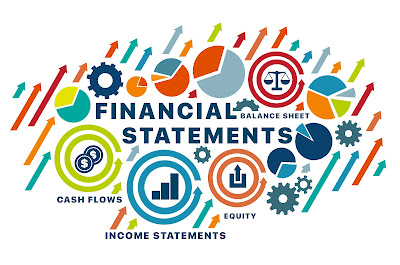Financial Statements
 |
| Financial Statements |
Introduction:
Financial statements are official records that pass on a company's financial status and execution. These explanations are reviewed by government bodies, bookkeepers, and businesses to guarantee precision and compliance. For-profit substances show adjust sheets, wage articulations, cash streams, and value changes. Non-profits utilize a comparable, however particular, set of financial statements.
Types of financial statements
1. Balance Sheet.
2. Income Statement.
3. Statement of Cash Flows
1. Balance Sheet
The balance sheet is one of three primary financial statements. These explanations are essential to budgetary modeling and accounting. The adjustment sheet shows a company’s add-up to resources and how these resources are financed through either obligation or value. The adjustment sheet is related to taking after essential conditions.
Assets = Liabilities + Value
Thus, the balance sheet is divided into two sides. The left-hand side of the balance sheet outlines the company’s assets. On the right-hand side, the adjustment sheet outlines the company’s liabilities and equities. On either side, the mainline things are generally classified by liquidity. More liquid accounts, such as inventory, cash, and trade payables, are set before illiquid accounts, such as plant, property, equipment, and long-term debt. Assets and liabilities are also separated by current assets/liabilities and long-term assets/liabilities.
How to set up the balance sheet?
Balance sheets, like all financial statements, will have minor divergence between organizations. Be that as it may, there are a few “buckets” and line things that are nearly continuously included in common adjust sheets. We briefly go through commonly found line things beneath Current Resources, Long-Term Resources, Current Liabilities, Long-Term Liabilities, and Value.
 |
| Balance Sheet |
2. Income Statement
The income statement is one of three critical statements, both in financial displaying and accounting. This statement shows the company’s income, costs, net benefit, offering and regulatory costs, other costs, pay, charges paid, and net benefit coherently and consistently. The statement is separated into periods that consistently take after the company’s operations. The most common intermittent division is month-to-month, although certain companies may utilize quarterly divisions or thirteen-month cycles.
How to set up the income statement?
The wage explanation may have minor varieties between diverse companies, as costs and wages will be subordinate to the type of operations or trade conducted. Be that as it may, there are a few non-specific line items that are commonly shown within the income statement.
Sales Income
The company’s income from deals or benefits is shown at the exceptionally beat of the explanation. This value will be net of the costs related to making the products sold, or in giving the benefit.
Cost of Goods Sold (COGS)
This line thing totals the coordinated costs related to accomplishing the income. Settled costs and overhead are prohibited.
Gross Profit
Gross profit is found by subtracting COGS from Deals Income.
SG&A Expenses
The selling, general, and administrative section will contain all other indirect costs associated with running the business. It includes salaries of management, advertising expenses, travel expenses, and sometimes depreciation and amortization, among others. Entities may, in any case, choose to put depreciation and amortization in their section.
EBITDA
While not displayed in all income statements, Earnings before Intrigued, Charge, Deterioration, and Amortization can be found by subtracting SG&A costs (excl. amortization and depreciation) from net benefit.
EBIT
Similarly, while not shown in all wage explanations, Profit before Interest and Tax is found by subtracting devaluation and amortization from EBITDA.
Interest Expense
It is common for companies to part out intrigued cost and interest income as an isolated line thing within the wage explanation. Usually done to be able to accommodate the contrast between EBIT and EBT. Intrigued, the cost is decided through the debt schedule.
EBT or Pretax Income
Profit before charge or pretax income is calculated by subtracting interest expense from EBIT. Typically, the final subtotal is some time recently finding a net salary.
Income Taxes
Income taxes refer to relevant charges to the pre-tax income.
Net Income
After deducting income taxes from pre-tax pay, the remaining amount is the net income. This can be the amount that flows into retained earnings, after deductions for any cash or stock profits.
 |
| Income Statement |
3. Statement of Cash Flows
The Statement of Cash Streams is one of the key statements that report money created and went through a particular period. Hence, compared to the pay explanation, these explanations cover a certain period, i.e., for the year finished December 31, 2017. The statement of cash flows is partitioned into three main sections:
Operating Section:
The principal revenue-generating exercises of an organization and other exercises that are not contributing or financing; are any cash streams from current resources and current liabilities.
Investing Section:
Any cash flows from the securing and transfer of long-term assets and other investments not included in cash counterparts.
Financing Section:
Any cash flows that result in changes within the estimate and composition of the contributed value and borrowings of the substance (i.e., bonds, stock, cash dividends).
 |
Statement of Cash Flows |
Conclusion:
Financial statements serve as formal records passing on a company's financial well-being and performance. These reports experience investigation by government bodies, accountants, and businesses to guarantee precision and compliance. For-profit substances display adjust sheets, income statements, and cash flow statements, whereas non-profits take after a comparable structure custom-made to their setting. The adjust sheet shows a company's resources and how they're financed, balancing assets with liabilities and value. The income statement outlines revenue, expenses, and net profit, facilitating operational knowledge. The statement of cash flows tracks cash generated and spent in operating, investing, and financing exercises. Together, these financial statements give a comprehensive preview of a company's financial landscape, supporting decision-making and strategic planning.






No comments:
Post a Comment